 The Christine Nowak Lectures, begun in 2013, in memory of Christine Nowak, are held at the Annual Meeting of the Blackstone Valley Historical Society. Christine Nowak was a respected local journalist and a past president of the Society. Upon her death she gave a bequest to the Society, which was placed in a fund in the R.I. Foundation in her name.
The Christine Nowak Lectures, begun in 2013, in memory of Christine Nowak, are held at the Annual Meeting of the Blackstone Valley Historical Society. Christine Nowak was a respected local journalist and a past president of the Society. Upon her death she gave a bequest to the Society, which was placed in a fund in the R.I. Foundation in her name.
Previous Lectures:
May, 2013. Albert Klyberg, The Christine Nowak Memorial: A legacy of the Blackstone Valley Writers Guild, the lure and lore of local history.
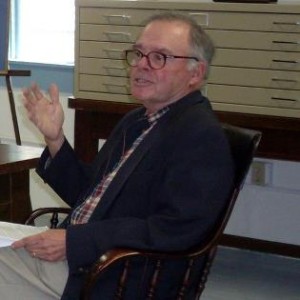 This was the first of our very special annual meetings. Al Klyberg, BVHS board member and noted local historian, introduced the first annual Christine Nowak presentation.
This was the first of our very special annual meetings. Al Klyberg, BVHS board member and noted local historian, introduced the first annual Christine Nowak presentation.
“The main themes of my talk,” says Al Klyberg, “are that it is difficult, believe it or not, to get members of an historical society to attend an annual meeting; and that it is difficult for historical agencies to actually find money in a budget loaded with building costs to direct funds to history.” “Chris’s bequest” he adds “allows us to do both. Chris’s career was in the tradition of the Blackstone Valley Writer’s Guild, which was the inspiration for the Blackstone Valley Historical Society more than 50 years ago. With Chris’s bequest, her legacy, it is now possible to encourage budding historians to focus on the ‘un-done’ work of Blackstone Valley History. “The bulk of my talk” explains Klyberg, “describes what some of the future Chris Nowak lectures could be about.”
May 2014: Kevin McBride, University of Connecticut and the Mashantucket Pequot Museum, Results of the Archaeological Investigation into the 2nd Battle of Nipsachuck Swamp, North Smithfield, RI.
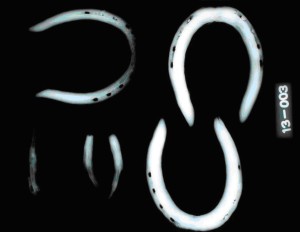 Dr. Kevin McBride, Director of Research at the Mashantucket Pequot Museum and professor of anthropology at the University of Connecticut presented he second Chris Nowak Memorial Lecture at the annual meeting of the Blackstone Valley Historical Society, Sunday, May 18, 2014 at 2:00 p.m. Dr. McBride, who is an expert on King Philip’s War, 1675-1676, will describe the results of his just concluded archaeological investigation of the 2nd battle of the Nipsachuck Swamp in North Smithfield, RI.
Dr. Kevin McBride, Director of Research at the Mashantucket Pequot Museum and professor of anthropology at the University of Connecticut presented he second Chris Nowak Memorial Lecture at the annual meeting of the Blackstone Valley Historical Society, Sunday, May 18, 2014 at 2:00 p.m. Dr. McBride, who is an expert on King Philip’s War, 1675-1676, will describe the results of his just concluded archaeological investigation of the 2nd battle of the Nipsachuck Swamp in North Smithfield, RI.
The dig was part of a multi-year investigation sponsored by the American Battlefield Protection Program of the National Park Service. The project was managed by the Rhode Island Historical Preservation and Heritage Commission (a state agency), The Narragansett Tribal Historic Preservation Office, which organized and led consultation with five other federally-recognized tribes in the Blackstone Valley region, and the Blackstone Valley Historical Society, which hosted meetings at North Gate and assisted in administering the Federal grants for the program.
The project was divided into two parts. The first work, in 2010 and 2011 was conducted by historians David Naumec and Sarah Holmes. Their work focused on reconstructing the physical layout of the site based on early land deed documents and maps; and a summary of the eyewitness accounts of the battles as recorded in the records and archives of Massachusetts, Connecticut, and Rhode Island.
Prof. McBride’s task in 2012 was to pin down the actual landscape of the battles and attempt to find surviving artifacts to confirm the tragic events that occurred there in the summers of 1675 and 1676. The battles of Nipsachuck Swamp were two of the largest engagements of King Philip’s War, and until now their exact locations have been unknown. Prof. McBride’s work has brought these important historical events to light. The second battle of Nipsachuck was selected for McBride’s study because the documentary evidence was stronger. Nipsachuck covers a large woodland area. Several hills, several swamps qualified as likely locations. The chance of actually determining the battlefield was greater for the second encounter.
His lecture will be the second in the series devoted to former Historical Society president, Christine Nowak. The plan is eventually to publish the lectures in an anthology of history of the Blackstone Valley.
The battles at Nipsachuck Hill and Swamp
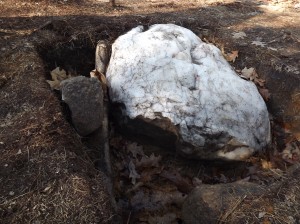 The Nipsachuck territory, centered on Nipsachuck Hill and Swamp in North Smithfield and Smithfield, RI, was the location of two important battles in King Philip’s War (1675-1676). The first battle occurred shortly after the beginning of the war, as colonial and Mohegan Indian forces pursued and fought the Wampanoag leader Philip and the Pocasset Tribe’s Saunk Squaw (Woman Chief) Weetamoo and their soldiers at Nipsachuck. Contemporary critics and historians condemned the militia for not defeating Philip and ending the war there; instead, Captain Henchman, perhaps uncertain of battle tactics in the densely-vegetated swampland, let the tribal defensive units of Philip and Weetamoo escape after inflicting some casualties, and the war continued for another year.
The Nipsachuck territory, centered on Nipsachuck Hill and Swamp in North Smithfield and Smithfield, RI, was the location of two important battles in King Philip’s War (1675-1676). The first battle occurred shortly after the beginning of the war, as colonial and Mohegan Indian forces pursued and fought the Wampanoag leader Philip and the Pocasset Tribe’s Saunk Squaw (Woman Chief) Weetamoo and their soldiers at Nipsachuck. Contemporary critics and historians condemned the militia for not defeating Philip and ending the war there; instead, Captain Henchman, perhaps uncertain of battle tactics in the densely-vegetated swampland, let the tribal defensive units of Philip and Weetamoo escape after inflicting some casualties, and the war continued for another year.
The second battle occurred just days before the war ended. By this time, colonial officers had adapted their battle tactics to swamp warfare as Connecticut and Mohegan Indian soldiers attacked, killed or took prisoner a large group of Narragansett, led by the elderly Saunk Squaw Quiapin, who had encamped at the base of a hill at the edge of Nipsachuck Swamp. This battle, according to several modern historians of the war, all but ended Narragansett resistance. from RIHPHC, Minutes, July 8, 2009
Image in last paragraph: Quartz rock at Nipsachuck, showing repeated use in artifact making.
May, 2015. David Harvey, Louisquisset: The quest for the “meeting place.”
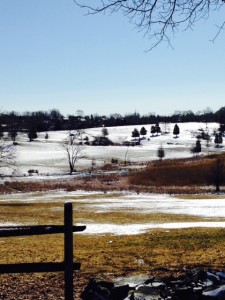 Mr. Harvey researched the Louisquisset area and gave a talk on his work.
Mr. Harvey researched the Louisquisset area and gave a talk on his work.
View from Wilbur Road.
May, 2016. Panel Presentation: The Early families of Cumberland, Lincoln, Pawtucket, North Smithfield, and Woonsocket.
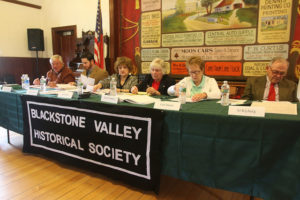
Rhode Island historian Al Klyberg brought together a panel discussion with a focus on the families who filtered back into the this region after King Philip’s War, in the period 1680 to 1731, when the ‘Outlands’ or North Woods of Providence were set off into the towns of Smithfield, Glocester, and Scituate. Although this discussion is not aimed at the genealogy of the families, several local historians will introduce you to their ways of life: their occupations, how they built their houses, what farm life was like hundreds of years ago.
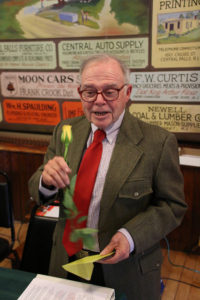
Al Klyberg chaired the panel and spoke about Central Falls and parts of Lincoln; Dan Santos of Historic New England spotlighted the Arnold family of Lincoln and Woonsocket; BVHS board member Gail Harris introduced her hometown of Cumberland, Irene Nebiker showcased North Smithfield, Irene Blais, Woonsocket, and Steve Todaro talked about Pawtucket.
May, 2017. Gail Mohanty, on Technology, Industrialization and the Landscape
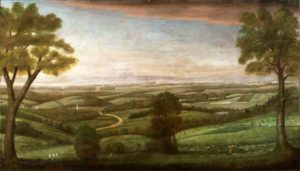
Her talk will trace the changes from the late 18th century through the first half of the 20th century using a series of landscape paintings as evidence of changes to the environment.
The availability of land in the New World and its seemingly untamed character had led the settlers to acquire land, clear it of trees, and create fields and farms. In this way, they had attempted to duplicate what was familiar and prized in their homeland.
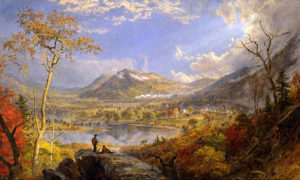
By the 18th century, these transplanted European residents had continued to idealize the pastoral landscape, and artists depicted the results in paint and print. By the end of the 18th century, a more diverse economy began to be developed, including some manufacturing and mining. By the first half of the 19th century the introduction of built elements to the environment were also incorporated into visual art and the conceptualization of the ideal began to change.
Dr. Mohanty is a native Rhode Islander who returned to the state in 1990, working at Slater Mill Historic Site initially, and then turned to teaching in 2001. She is currently an Adjunct Faculty member in the History and Social Studies Department at Bryant University and Senior Lecturer, Liberal Arts at the Rhode Island School of Design.
May 2018. Kevin Klyberg, Ranger, Blackstone Valley Historic Park, The War of 1812 and the Development of the Blackstone Valley.
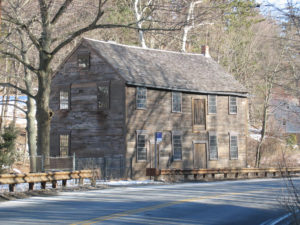
The War of 1812 played a major role in the industrialization of the Blackstone Valley. While obviously no battles were fought here, the War of 1812 and the embargoes leading up to the war played a key role in launching the first textile industry boom in the Blackstone Valley, and therefore the United States, according to Kevin Klyberg, a national park ranger, who will be giving the annual Christine Nowak Memorial Lecture on May 20 at 2:00 pm.
Klyberg continues, “The ban on importation of textiles from Europe, beginning in 1807, inspired the creation of dozens of new textile mills across the Blackstone Valley. In many ways, the cotton mill boom of this era is what really made the Industrial Revolution revolutionary, as it expanded the textile industry beyond a handful of sites. By 1815 the Blackstone Valley had transformed into an industrial landscape, and the United States was on its way to becoming a manufacturing powerhouse. “
Ranger Kevin Klyberg has been working with the National Park Service for 21 years, first for the Blackstone River Valley National Heritage Corridor and now for the Blackstone River Valley National Historical Park (www.nps.gov/blac/index.htm). During that time he has shared the sites and stories of the Blackstone Valley with thousands of visitors.
May 2019. Kevin Klyberg, Ranger, Blackstone River Valley National Historic Park, Blackstone Canal: Highway to the Headwaters.
Location: Barn of the Captain Wilbur Kelly House Museum, 1071 Lower River Road, Lincoln, RI 02865
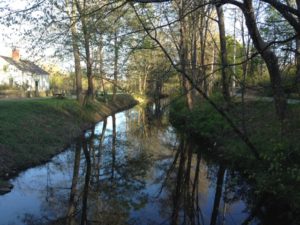
Ranger Kevin Klyberg, from the Blackstone River Valley National Historic Park, will give the BVHS’s annual Christine Nowak Lecture. The talk, “Blackstone Canal: Highway to the Headwaters, will take place at 2:00 p.m, immediately after the BVHS annual meeting. There will be a shuttle to take people from the small parking lot to the barn.
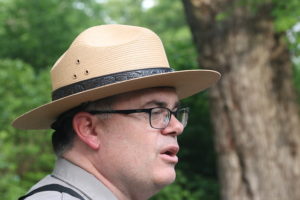
The Blackstone Canal connected Worcester to Providence and was in use from 1828 to 1848. Construction started in 1825, and was completed in 1828. It increased prosperity for the Blackstone Valley. Farmers’ goods were easier to ship by water instead of along the dirt roads, and mills sprang up along the river. It was a two day trip for canal boats from Worcester to Providence. An overnight stop was made in Uxbridge. The canal was approximately 35 feet wide and ascended 451 feet, passing through 49 locks. It was designed by Benjamin Wright, chief engineer of the Erie Canal, and Holmes Hutchinson, later chief engineer of New York’s canals. However, in 1847, the Providence and Worcester Railroad opened, and the canal quickly became obsolete.
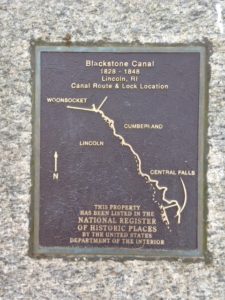
This lecture is free.
2020: No Lecture Given
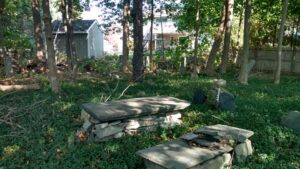
June 27, 2021: Ken Postle, Inconvenient Burials. Ken Postle, BVHS Cemetery Coordinator, spoke about his work preserving historic cemeteries
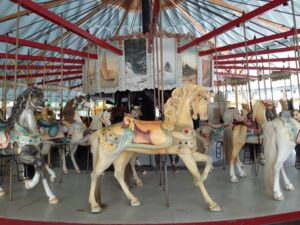
May 15, 2022: Donna Houle, The Looff Carousel. Donna Houle, Friends of the Looff Carousel at Slater Park, gave a presentation and showed a film on the history of the carousel and about recent about work restoring and preserving it.

May 21, 2023: Kevin Klyberg, Slater Mill to Slatersville. Kevin Klyberg, Blackstone River Valley National Historic Park talked about the history of the development of the mills in the Blackstone Valley.